2007 is over. A good year? For horror literature I’d say yes, it was. The following represents my overview of 2007—the good, the bad and the indifferent. Obviously I was unable to read to read every horror-themed book published in ’07 (and regrettably missed some biggies, like Jeff Long’s DEEPER, David Wellington’s 13 BULLETS and Chuck Palahniuk’s RANT) but feel the 20+ short reviews herein represent a solid and eclectic sampling.
Thinking back over the past year, I’ll have to say my reception by the literary horror community was gratifyingly positive—my thanks to all the authors and publishers who provided me with review copies of their books—but there was one point of contention.
That would be the first-time writer(s). Yes, I’ve had a couple bad experiences with first-timers upset that I gave their alleged masterpieces something other than unqualified raves. I can understand that attitude (and can’t say I don’t share it myself, at least partially), and nor can I really complain about their criticism (if one is going to give it, after all, one has to be able to take it). What has gotten to me is the charge that I might be destroying these writers’ careers before they properly begin. I strongly disbelieve I have enough clout to influence anyone’s career, but the thought of inadvertently curtailing an author’s oeuvre with a single middling-to-negative review (as, believe it or not, one beginning writer has claimed) is troubling enough to give me pause. For this reason I’ve refrained from writing about some first time novels that have crossed my desk, and may continue to do so in the future.
That’s not to say I’ve been keeping mum about all debut novels. Far from it; you’ll find several such books critiqued in the following list. First, though, I’d like to get one VERY important category out of the way.
Ladies and gentlemen, let’s give it up for…
THE BOOK OF THE YEAR
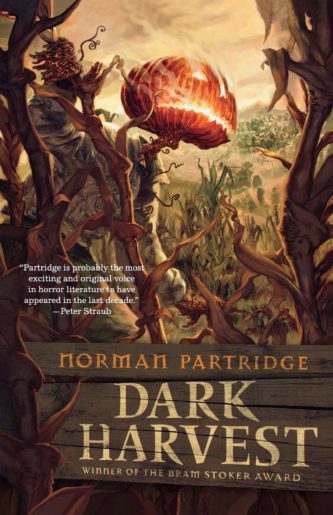 My pick is the astonishing DARK HARVEST by NORMAN PARTRIDGE, a short novel that provides ample doses of grue, breakneck action and touching introspection, often within a single sentence. Some of you might have gotten a hold of this must-have book back in 2006, when it was first published as a limited edition hardcover by Cemetery Dance. Now, though, it’s available in a trade paperback printing courtesy of Tor, in which guise I’m guessing it will reach the large readership it so ardently deserves.
My pick is the astonishing DARK HARVEST by NORMAN PARTRIDGE, a short novel that provides ample doses of grue, breakneck action and touching introspection, often within a single sentence. Some of you might have gotten a hold of this must-have book back in 2006, when it was first published as a limited edition hardcover by Cemetery Dance. Now, though, it’s available in a trade paperback printing courtesy of Tor, in which guise I’m guessing it will reach the large readership it so ardently deserves.
Reading like a testosterone-fueled rethink of Shirley Jackson’s classic tale “The Lottery”, DARK HARVEST is set over the course of Halloween night, 1963, in a small Midwestern town. The teenage boys of the community are following a yearly ritual of hunting a supernatural entity called the October Boy, a pumpkin-headed scarecrow-like figure whose insides are stuffed with candy. The town’s elders ensure that the boys enact the “Run” each Halloween by not allowing them to eat for five days and then turning them loose, armed with knives and pitchforks. But this year’s Run will go a little differently. Pete, a young man fired up to take down the October Boy, stumbles onto some dark secrets that shine a whole new light on the Run, the October Boy, and the town itself.
The novel is quite simply a small classic, related from a completely absorbing, smart-aleckey first person perspective (although we don’t actually find out who the narrator is until halfway into the book) that manages to be highly stylish and individual without ever compromising or reducing the events of the narrative in any way. The author also deserves kudos for turning out such a focused and compact piece of work, which at 169 pages manages to relate a tale as rich and satisfying as nearly any 500-page epic.
FIRST TIMERS, PRO AND CON
I’ll continue this overview with a look at a first-time novel I really liked. Matter of fact, I’d say it’s one of the most powerful 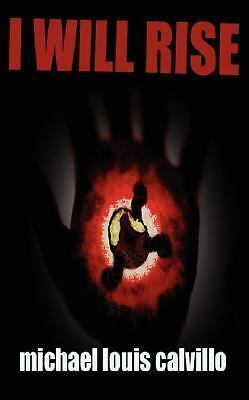 and original—and, unfortunately, obscure—books of the year. It’s I WILL RISE by MICHAEL LOUIS CALVILLO (Lachesis Publishing), one of the most promising debuts I’ve encountered in some time.
and original—and, unfortunately, obscure—books of the year. It’s I WILL RISE by MICHAEL LOUIS CALVILLO (Lachesis Publishing), one of the most promising debuts I’ve encountered in some time.
Told in a stream-of-consciousness style vaguely reminiscent of authors like Chuck Palahniuk and Kathe Koja, this novel relates the warped tale of Charles, a severely alienated, ugly, misanthropic virgin who’s prone to seizures and suffers from a weird birth defect: a hole in his left palm. When we first meet Charles he’s working in a restaurant he plans to sabotage by spiking its flour supply with Ajax, but he’s caught in the act and shot to death by cops. Yet Charles is brought back to life with a mission to snuff out the “human virus”, which he can do simply by touching people with his mutant left hand. 24 hours later the recipients die, but not before passing on the killing touch themselves, thus spreading death across the globe. Charles is assisted in his quest by Annabelle, an equally disenfranchised misanthrope who contacts Charles through her dreams, even projecting an idealized image of herself as a hot, scantily clad babe to help him along. In real life, though, Annabelle is a dumpy blind woman who lives in squalor with her mother. Her interaction with Charles helps to humanize him somewhat, giving him second thoughts about his mission to destroy humanity.
Other bizarre characters include a five-year-old genius with ESP who accompanies Charles through the early stages of his odyssey, a gaggle of crazies who learn of Charles’ mission through shared dreams, and Allen Michael, a slimy TV personality who becomes the focus of Charles’ rampage, especially after Charles discovers Annabelle may have been psychically two-timing him with Mike. These characters’ interactions make for a wild ride, written with real assurance and a slip-streamy, pop-inflected vernacular that often imparts the feel of a psychotic nightmare, or perhaps a near-death hallucination.
At the opposite end of the debut novel spectrum we have CROOKED LITTLE VEIN by WARREN ELLIS (William Morrow). I guess this “frighteningly clever” book isn’t entirely bad, just misguided. It left me cold in any event, being a too-hip-for-the-room black humored account of a depraved future world where a disaffected private dick searches for an alternate constitution. This first person narrator has a cynical, wise-ass prose style and a pop culture reference for every occasion. Seemingly everyone he meets is sex-mad in some way, and they do things like inject our hero’s balls with salt water. The book has its moments, and might well have seemed pretty cool, oh, thirteen years ago—despite the author’s up-to-date political conscience (with references to the war in Iraq, the California Governator, etc.), it’s a very nineties concoction, the kind of thing that back then would have been labeled grunge, post-punk or Tarantino-esque. These days I’d call it, simply, dated. Not that author Warren Ellis has anything to worry about, being a well-established graphic novelist and scriptwriter. As a non-graphic novel writer, though, he’s clearly got a ways to go.
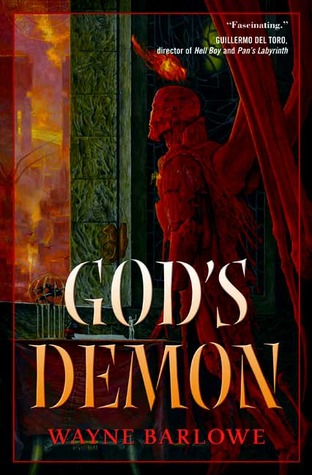 Back to the good stuff, in particular the stunningly ambitious GOD’S DEMON, the first novel by the famed artist WAYNE BARLOWE (Tor). After wading through so many uninspired modern horror novels I’ve been longing for something with a bit more scope—I was more than pleased, then, to discover this book, a panoramic, multi-faceted epic set in Hell.
Back to the good stuff, in particular the stunningly ambitious GOD’S DEMON, the first novel by the famed artist WAYNE BARLOWE (Tor). After wading through so many uninspired modern horror novels I’ve been longing for something with a bit more scope—I was more than pleased, then, to discover this book, a panoramic, multi-faceted epic set in Hell.
The inferno of GOD’S DEMON is composed of far-flung cities run by various fallen angels. Two such cities are singled out: Dis, the infernal capital built by Lucifer himself, and Adamantinarx, a more advanced metropolis run by Lord Sargatanas, who has never entirely forgotten his time in Heaven–and, as the book opens, secretly longs to go back. There’s also Lucifer’s consort Lilith, who develops an attraction to Sargatanas, and Beelzebub, the Lord of the Flies. The latter was Lucifer’s right hand man but now rules Hell, his master having mysteriously disappeared. The result is an all-out war–or a rebellion to be exact, not unlike that which got the onetime angles booted from Heaven. Only this time the rebels are demons, led by Sargatanas, going up against their own kind, in the form of Beelzebub and his minions, in an effort to be let back into the overworld.
Barlowe’s many larger-than-life protagonists are all well developed, three-dimensional individuals tormented by doubts and misgivings about their longed-for redemption. That’s in addition to Barlowe’s considerable descriptive powers, every bit as vivid and grandiose as I’d expect from an artist-turned-writer, yet still succinct and to the point. But there’s one thing that bothers me. Not to give anything away, but a certain two personages pivotal to any account of Heaven and Hell never make an appearance outside a few scattered flashbacks. I’m assuming a sequel is in the works wherein these characters finally turn up, because their absence frankly leaves a bit of a void. Terrific novel nonetheless!
By contrast, I’ll confess I wasn’t as impressed by HEART-SHAPED BOX (William Morrow), the first novel by author 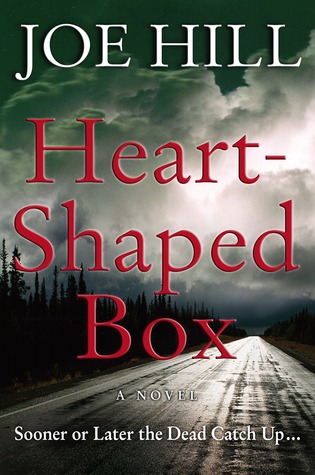 JOE HILL, as I know many of you are. Hill of course is the author of the stunning ’05 collection 20th CENTURY GHOSTS, which I’ve been pushing for some time. His facility with horror isn’t surprising, seeing as how he’s the son of Stephen King (a secret, I might add, that’s been out for some time, so don’t blame me for blowing Hill’s cover!). HEART-SHAPED BOX has a riveting premise involving Judas Coyne, an ageing death metal icon who purchases a ghost over the internet. Actually he buys a suit belonging to a deceased man that arrives in a heart-shaped box; but the suit does indeed contain its previous owner’s unquiet spirit, who takes to harassing Judas to no end. This inspires a road trip together with his goth GF Georgia, during which Judas is forced to confront the specter of his abusive father and his own past sins, which it turns out inspired the sale of the ghost in the first place. A solid, up-to-date tale that’s never particularly horrific, although the author makes a half-hearted nod to the type of all-stops-out terror practiced by his father in the mystical climax. The book may ultimately be a bit too long, with an overabundance of character development in place of incident, although it is damn good—but still far from great.
JOE HILL, as I know many of you are. Hill of course is the author of the stunning ’05 collection 20th CENTURY GHOSTS, which I’ve been pushing for some time. His facility with horror isn’t surprising, seeing as how he’s the son of Stephen King (a secret, I might add, that’s been out for some time, so don’t blame me for blowing Hill’s cover!). HEART-SHAPED BOX has a riveting premise involving Judas Coyne, an ageing death metal icon who purchases a ghost over the internet. Actually he buys a suit belonging to a deceased man that arrives in a heart-shaped box; but the suit does indeed contain its previous owner’s unquiet spirit, who takes to harassing Judas to no end. This inspires a road trip together with his goth GF Georgia, during which Judas is forced to confront the specter of his abusive father and his own past sins, which it turns out inspired the sale of the ghost in the first place. A solid, up-to-date tale that’s never particularly horrific, although the author makes a half-hearted nod to the type of all-stops-out terror practiced by his father in the mystical climax. The book may ultimately be a bit too long, with an overabundance of character development in place of incident, although it is damn good—but still far from great.
(Here I should add that I strongly recommend grabbing Hill’s masterful 20th CENTURY GHOSTS. I’ve already written about this must-read collection, initially published in a limited edition by PS Publishing, at some length on this site, and so will spare you any further raves. Suffice it to say that the book is now out in a more readily available edition courtesy of William Morrow, so you no longer have any excuse not to read it!)
My final debut novel selection is A GOOD AND HAPPY CHILD by JUSTIN EVANS. Publisher Shaye Areheart was clearly shooting for a best seller, putting the novel out in a glossy hardback edition whose packaging suggests a highbrow literary thriller. Don’t be fooled, though: this is very much a horror story with all the trimmings—I’m just not sure it’s all that great a novel, whatever its category.
The first-person hero George Davies is a seemingly contented man who at the urging of a psychiatrist takes to writing down experiences from his childhood. They include a series of hallucinatory visits from a spectral doppelganger and young George’s subsequent incarceration in a mental hospital. George’s deceased father is somehow responsible for his son’s childhood problems, it seems, which are spilling over into George’s adult relationships with his wife and infant child. I say seems because the author never satisfactorily explains his protagonist’s visions. The book is well written and psychologically astute, but it’s also overly long at 336 pages (of which I feel it could stand to comfortably loose about fifty) and ultimately unsatisfying. Justin Evans was apparently of the same mind as his publisher, intentionally playing down the genre elements in his inconclusive ending, which for me simply didn’t work.
NEW BOOKS, GOOD AND NOT-SO, BY OLD MASTERS
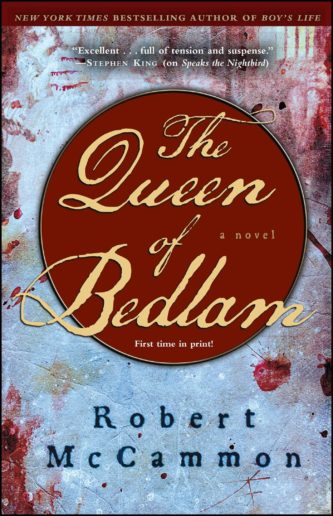 ROBERT McCAMMON, formerly one of America’s premiere horror writers (with SWAN SONG, STINGER, THE WOLF’S HOUR et al), followed up his 2002 historical triumph SPEAKS THE NIGHTBIRD with THE QUEEN OF BEDLAM (Pocket), another gripping period saga. The setting this time is a scrupulously researched, detailed and atmospheric New York City during the early 1700s, which is haunted by a shadowy menace. That menace is a maniac known as the Masker, a prototypical serial killer who leaves his horrifically mutilated victims with the flesh around their eyes carved out in distinctly mask-like fashion. The young Matthew Corbett, the hero of SPEAKS THE NIGHTBIRD, is working as a NYC law clerk when the Masker strikes. Matthew is initially a distant observer to the Masker’s demented handiwork, but gets drawn into the case head first upon witnessing the Masker at work on a new victim—who just happens to have been the headmaster at the orphanage where Matthew grew up.
ROBERT McCAMMON, formerly one of America’s premiere horror writers (with SWAN SONG, STINGER, THE WOLF’S HOUR et al), followed up his 2002 historical triumph SPEAKS THE NIGHTBIRD with THE QUEEN OF BEDLAM (Pocket), another gripping period saga. The setting this time is a scrupulously researched, detailed and atmospheric New York City during the early 1700s, which is haunted by a shadowy menace. That menace is a maniac known as the Masker, a prototypical serial killer who leaves his horrifically mutilated victims with the flesh around their eyes carved out in distinctly mask-like fashion. The young Matthew Corbett, the hero of SPEAKS THE NIGHTBIRD, is working as a NYC law clerk when the Masker strikes. Matthew is initially a distant observer to the Masker’s demented handiwork, but gets drawn into the case head first upon witnessing the Masker at work on a new victim—who just happens to have been the headmaster at the orphanage where Matthew grew up.
What follows is suspenseful and satisfying, with Matthew making the acquaintance of many suspicious characters and eventually finding his way to the eponymous insane asylum. There the “Queen”, a near-catatonic woman who in place of speech repeats a few seemingly nonsensical phrases, is interred, who holds the key to unraveling the mystery of the Masker. This book, like its predecessor, represents prime McCammon: it boasts the type of breakneck action set pieces and virtuoso plotting that distinguished his earlier books, with a superbly paced, incident-packed 645-page count. But THE QUEEN OF BEDLAM also contains a maturity and sophistication that place Robert McCammon among the front-ranks of American novelists.
The UK’s great RAMSEY CAMPBELL was back with another novel, less than a year after his last one (the good-but-not-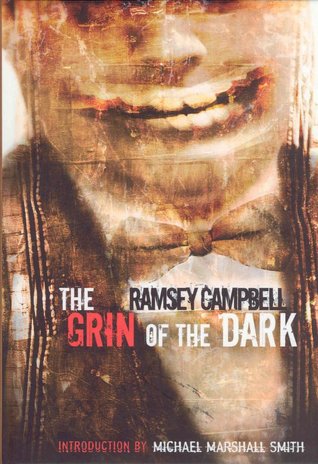 great SECRET STORY) appeared. THE GRIN OF THE DARK (PS Publishing) is easily his finest work in I-can’t-remember-how-long, with Campbell returning to the type of psychological dread that made his name. It’s the story of Tubby Thackery, a forgotten Fatty Arbuckle-esque silent movie comedian, and Simon Lester, the unlucky film buff assigned to track down Thackery’s films so he can write a book about them. Thackery, it seems, made contact with a supernatural entity that’s using his films to spread a sort of malignant mind-virus; this means Simon Lester, in his blundering, ignorant fashion, is unwittingly doing just that on his increasingly horrific odyssey. Along the way Simon gets into an online tiff with a pesky imdb message board poster, briefly stays in the home of a porno impresario who happens to be the granddaughter of Thackery’s stock director, unaccountably gets his bank account cleaned out, and finds that Thackery’s face, with its perpetual grin, has a way of turning up everywhere Simon goes.
great SECRET STORY) appeared. THE GRIN OF THE DARK (PS Publishing) is easily his finest work in I-can’t-remember-how-long, with Campbell returning to the type of psychological dread that made his name. It’s the story of Tubby Thackery, a forgotten Fatty Arbuckle-esque silent movie comedian, and Simon Lester, the unlucky film buff assigned to track down Thackery’s films so he can write a book about them. Thackery, it seems, made contact with a supernatural entity that’s using his films to spread a sort of malignant mind-virus; this means Simon Lester, in his blundering, ignorant fashion, is unwittingly doing just that on his increasingly horrific odyssey. Along the way Simon gets into an online tiff with a pesky imdb message board poster, briefly stays in the home of a porno impresario who happens to be the granddaughter of Thackery’s stock director, unaccountably gets his bank account cleaned out, and finds that Thackery’s face, with its perpetual grin, has a way of turning up everywhere Simon goes.
The book begins in relaxed and amiable fashion, but the tension steadily mounts—and all-but explodes during the final hundred or so pages, which contain some of the most unnerving prose Campbell has ever written. I’ll confess I was astounded at just how disquieting this novel turned out to be, with a minutely described reality breakdown that stayed with me long after I’d finished the thing. Be careful with this book, written as it is by an author who really knows how to scare, and isn’t shy about doing so!
The prolific DAN SIMMONS, who’s come under fire recently for alleged racist sentiments, turned out the massive THE TERROR (Little, Brown), one of his best novels in years. If you were put off reading this book because of the racial furor (as many otherwise-intelligent people I know say they were), here’s some unsolicited advice: kick yourself and grab a copy already!
It tells the fact-based tale of the 1845 Franklin Expedition to search for the Norwest Passage, as experienced by the crews of the HMS Erebus and the HMS Terror. The ships disembark in May of 1845, but upon reaching the Arctic Circle get stuck in the ice, leading to a relentless odyssey of desperation, scurvy, starvation and cannibalism. Most horrific of all, however, is the fact that a malevolent ice-dwelling monstrosity is afoot, bearing some relation to a mute Inuit woman the explorers unwisely allow into their sanctum.
THE TERROR is a damn good book, though far from an easy read. Its 766 pages are extremely detailed, the product of a voluminous, near-obsessive amount of research. There’s also the fact that the narrative is often agonizingly slow-moving, with every plot point relentlessly drawn out. But what THE TERROR lacks in thrills it more than makes up for in color and atmosphere. It’s a definite you-are-there account that’ll likely have you shivering along with its doomed protagonists, and nervously glancing over your shoulder for monsters in the shadows.
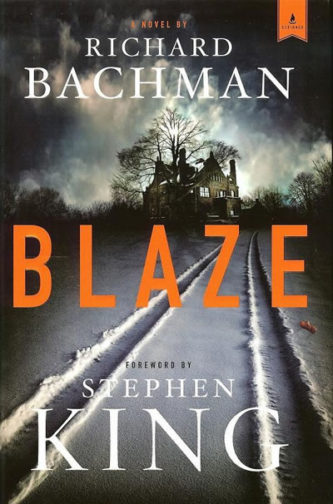 There was also STEPHEN KING, who gave us BLAZE (Scribner), a rediscovered manuscript–credited to King’s longtime pseudonym Richard Bachman—that hails from back before CARRIE (King’s “first” novel) was published. King claims in a newly written forward that he dusted BLAZE off in 2006 and redrafted it substantially, but was careful to keep the book’s pulpy core intact. The result is a compelling piece of crime fiction that reads like OF MICE AND MEN reimagined by Jim Thompson. The central character is Clayton Blaisdell, Jr., or Blaze, a near-retarded career criminal looking to pull off one last big job together with his miscreant buddy George. The only thing is, George is killed before the crime—the kidnapping of a rich man’s baby—can commence. Blaze goes through with it anyway however, guided by George’s specter.
There was also STEPHEN KING, who gave us BLAZE (Scribner), a rediscovered manuscript–credited to King’s longtime pseudonym Richard Bachman—that hails from back before CARRIE (King’s “first” novel) was published. King claims in a newly written forward that he dusted BLAZE off in 2006 and redrafted it substantially, but was careful to keep the book’s pulpy core intact. The result is a compelling piece of crime fiction that reads like OF MICE AND MEN reimagined by Jim Thompson. The central character is Clayton Blaisdell, Jr., or Blaze, a near-retarded career criminal looking to pull off one last big job together with his miscreant buddy George. The only thing is, George is killed before the crime—the kidnapping of a rich man’s baby—can commence. Blaze goes through with it anyway however, guided by George’s specter.
The story isn’t exactly original or unpredictable. As you might guess, Blaze botches the crime spectacularly, inadvertently alerting the FBI to his trail, and develops a soft spot for his infant kidnapee in the process. I enjoyed the exchanges between Blaze and George’s increasingly bloodthirsty specter, who wants Blaze to kill the child, thus adding a horrific tinge to the proceedings. As for Blaze himself, he’s a compelling character, both menacing and sympathetic. His final stand is grim (again, no surprises there) but also deeply memorable and even touching.
Do by all means check out LOST ECHOES by JOE R. LANSDALE (Vintage), one of the author’s best novels in some time. LOST ECHOES was marketed as a crime novel, but for the most part it’s a leisurely, contemplative account of Harry Wilkes, a modest East Texas resident with a unique talent: he can visualize past crimes, triggered by sounds. This “gift” makes Harry rather fearful, a bit like a redneck cousin to THE DEAD ZONE’S haunted protagonist. But then Harry meets Tad, a booze-addled Sensei. Tad teaches Harry to control his emotions through a strict regimen of martial arts training, finding in his young charge a replacement for the son he lost long ago—although this does nothing to curb his drinking problem. Thus for roughly the first two thirds we have a warm, funny, sometimes gruesome character-centered account.
It’s only in the final hundred pages that the crime business really kicks in, with a childhood crush who’s now a police officer contacting Harry about using his talents to solve her father’s murder. He follows through on her request, which sets in motion a particularly nasty chain of events. After the languidness of so much of the novel, it’s a bit disconcerting when the author’s gift for bloody suspense emerges with a vengeance in the final chapters, which close the book out with much over-the-top action and carnage. Somehow it all works, making for a soulful yet hard-edged account from one of the most distinctive writers currently active in any genre.
Another of my favorite authors, the one and only CLIVE BARKER, reignited his stalled literary career with MISTER B. 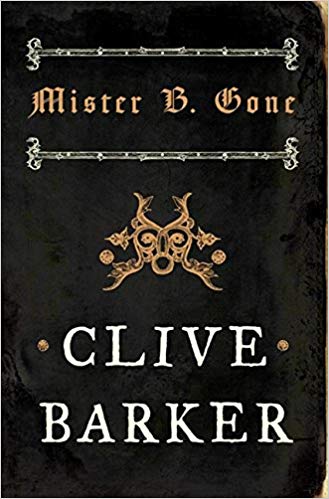 GONE (HarperCollins). This slim novel was dubbed “Twisted” and “Fucked-up” by its own author, who also claimed it “wants to kill you”. Barker is referring to the frequent pleas made to the reader by the story’s first person narrator to burn the book or die. That narrator is Jakob Botch, a Hell-spawned demon loose in Europe during the Middle Ages. In between all the threats and entreaties, Botch relates the story of his life: how he grew up in an abusive household in one of the lower regions of Hell, how he got reeled up above ground and killed his own father in the process, and how he embarked on a killing rampage and eventually met a grim fate. Throughout it all Botch tantalizes us with a secret he found out at the end of his journey, which he promises to reveal in the final pages. A secret is indeed enclosed near the end, which has something to do with the invention of the Guttenberg printing press—and which explains Botch’s eagerness for us to burn the book.
GONE (HarperCollins). This slim novel was dubbed “Twisted” and “Fucked-up” by its own author, who also claimed it “wants to kill you”. Barker is referring to the frequent pleas made to the reader by the story’s first person narrator to burn the book or die. That narrator is Jakob Botch, a Hell-spawned demon loose in Europe during the Middle Ages. In between all the threats and entreaties, Botch relates the story of his life: how he grew up in an abusive household in one of the lower regions of Hell, how he got reeled up above ground and killed his own father in the process, and how he embarked on a killing rampage and eventually met a grim fate. Throughout it all Botch tantalizes us with a secret he found out at the end of his journey, which he promises to reveal in the final pages. A secret is indeed enclosed near the end, which has something to do with the invention of the Guttenberg printing press—and which explains Botch’s eagerness for us to burn the book.
The story’s a good one, fast, readable and containing some potent grotesquerie. It is, however, a slight work, reading like nothing so much as a novel-length BOOKS OF BLOOD tale. Nothing wrong with that, but I think it’s fair to expect a bit more from a writer who’s become extremely unprolific in recent years. Consider it a warm-up for Barker’s long-in-the-works epic THE SCARLET GOSPELS, which will hopefully be completed soon
SCAVENGER (Vanguard Press) is another offering from a longtime master, the legendary DAVID MORRELL. It recounts the further adventures of Frank Balenger, the hero of Morrell’s previous novel CREEPERS. That book represented a welcome return to the horror/suspense genre of Morrell’s early novels FIRST BLOOD, TESTAMENT and THE TOTEM, which he largely abandoned in later, more mainstream efforts like THE BROTHERHOOD OF THE ROSE and DESPERATE MEASURES. SCAVENGER for the most part follows CREEPERS’ lead, with a grim, cliff-hanger packed account of a maniacal “Game Master” who leads several unwitting folks, including Frank Balenger and his girlfriend Amanda (another holdover from CREEPERS) into a New Jersey waste land as part of an insanely complicated game whose players must follow the Game Master’s instructions or get blown up. This of course was nearly the plot of THE CRIMSON LABYRINTH by Yusuke Kishi (released in the US last year), although Morrell enhances the material with his undeniable storytelling genius. He also adds an intriguing dimension in the reality-based search for time capsules, in this case something called The Sepulcher of Wordly Desires, which has apparently been hidden away for years in the very area where SCAVENGER’S protagonists are stranded. The revelation of just what the Sepulcher consists of is a shocker, although the conclusion, involving a final confrontation with the shadowy Game Master, leaves much to be desired. SCAVENGER is in the end a diverting enough thriller, but far from Morrell’s best work.
2 TWO-FOR-ONES
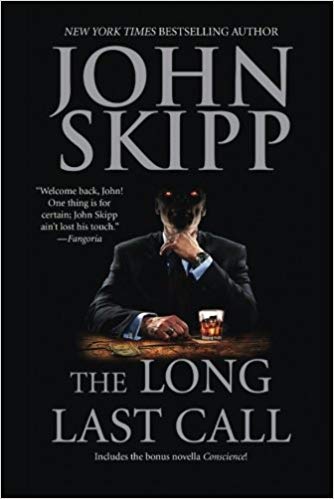 Looking for a stellar read? Try THE LONG LAST CALL by JOHN SKIPP. This is a must-have package from the good folk at Leisure, who’ve put out the terrific short novel THE LONG LAST CALL (originally published by Cemetery Dance back in ’06), together with the ’04 novella CONSCIENCE. John Skipp, formerly of Skipp and Spector (THE LIGHT AT THE END, THE SCREAM and THE BRIDGE) was one of the forerunners of the splatterpunk movement, and has a taut, gripping style and cinematic narrative skills. Speaking of which, THE LONG LAST CALL apparently began life as a screenplay but was refashioned into a novel when Skipp couldn’t find financing for the film.
Looking for a stellar read? Try THE LONG LAST CALL by JOHN SKIPP. This is a must-have package from the good folk at Leisure, who’ve put out the terrific short novel THE LONG LAST CALL (originally published by Cemetery Dance back in ’06), together with the ’04 novella CONSCIENCE. John Skipp, formerly of Skipp and Spector (THE LIGHT AT THE END, THE SCREAM and THE BRIDGE) was one of the forerunners of the splatterpunk movement, and has a taut, gripping style and cinematic narrative skills. Speaking of which, THE LONG LAST CALL apparently began life as a screenplay but was refashioned into a novel when Skipp couldn’t find financing for the film.
The set-up is this: around 2 AM at a secluded titty bar called Sweet Thangs, a dark stranger shows up with an apparently limitless supply of hundred dollar bills. But these aren’t ordinary bills by any means, as they affect the people they come into contact with in various disturbing ways—most notably, they seem to increase whatever innately vile, evil traits those people may possess. The stranger is there to witness a show of his own–a horror show, to be exact—with Sweet Thangs’ nasty, brutish clientele of whores, rednecks and assorted no-hopers the unwitting performers. The proceedings, you can be sure, are fast, wet and meaty, with a goodly amount of gore and a flawlessly sustained intensity. Call it literary speed metal, a noisy, headbanging, can’t-put-it-down splatfest that’s positively irresistible.
CONSCIENCE, by contrast, is a brooding look into the fractured psyche of a tortured hitman in La-La Land, and what happens when the guy begins to lose his mind—or so it seems. I’ll refrain from divulging too much, and leave you to experience the tale’s many head-snapping twists on your own. Taken together, these blistering novellas comprise an excellent sampling of John Skipp’s considerable skills. More please!
Let’s continue with another Leisure two-for, WICKED THINGS by THOMAS TESSIER, which was paired with Tessier’s 2001 novella SCRAMBURG, USA. Neither, alas, represents the author at his best. That’s a shame, because Thomas Tessier has long been one of my favorite horror writers, with quite a few superb novels to his credit, particularly THE NIGHTWALKER, PHANTOM, FINISHING TOUCHES and 1996’s unquestioned masterpiece FOG HEART. Even in lesser works like SHOCK WAVES and SECRET STRANGERS, Tessier’s considerable descriptive skills and narrative mastery are always fully evident.
So what the Hell happened with WICKED THINGS, a clunker in every respect? It has an insurance investigator entering a secluded upstate New York community to look into some suspicious deaths. There are dark secrets afoot, of course, involving a shadowy religious cult operating in the area and a secluded field that’s apparently the sight of freaky paranormal happenings. The prose is clean and focused in true Tessier fashion, but his story is standard stuff, and wilts entirely in the lazy conclusion, which ends the book with virtually nothing resolved.
SCRAMBURG, USA at least has a riveting build-up involving a rebellious teen declaring war on the corrupt residents of a small town, and contains some startling scenes of torture and bloodletting (no surprise: the tale is dedicated to Dallas Mayr, a.k.a. Jack Ketchum). The ill-conceived supernatural finale, however, is inexcusable. Tessier remains an uncommonly gifted author; I can only hope these two bummers represent a blip on his radar!
A “FUNNY” BOOK
It’s time here for a funny book, or at least one that was supposed to be funny: YOU SUCK by CHRISTOPHER MOORE 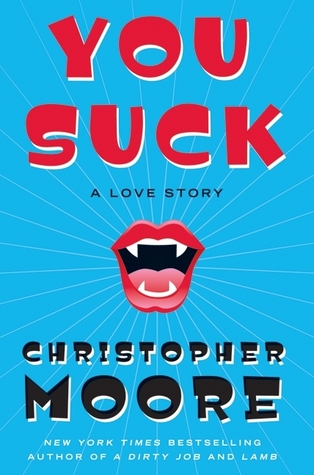 (William Morrow). It’s the first novel I’ve read by Moore, who for years has specialized in goofy horror-themed stories. I’m told YOU SUCK is pretty typical of his work; if that’s actually the case then it’s a damn good thing I’ve avoided it for so long!
(William Morrow). It’s the first novel I’ve read by Moore, who for years has specialized in goofy horror-themed stories. I’m told YOU SUCK is pretty typical of his work; if that’s actually the case then it’s a damn good thing I’ve avoided it for so long!
It’s a vampire love story set in San Francisco, where lowly Safeway employee Tommy is bitten by his undead girlfriend Jody, and so has to deal with life as a creature of the night. This entails sucking the blood from a skinned cat, tangling with the centuries-old vamp that turned Jody, dealing with a precocious teenage goth chick named Abby Normal, and fending off a reckless gang of fellow Safeway workers who call themselves the Animals. There’s also the fact that Tommy has to make a kill in order to prove to Jody that he’s a “real vampire”, something he finds difficult to do. All this makes for a lively book that begins in rollicking fashion (I particularly enjoyed a short chapter called “The Last Poop”), but grows tiresome quickly. It’s all very jokey and light hearted, so much so that it was difficult taking any of it seriously, which made finishing the book something of a chore. If horror-comedy is your thing by all means dig right in…but it definitely ain’t mine!
ODDITIES
THE OTHER END was a daring and controversial release from Cemetery Dance, in which the insanely prolific JOHN SHIRLEY returned to the type of tripped-out weirdness that in my view characterizes his best work, but with a disconcertingly cheerful, wish-fulfillment air. It’s an unabashedly left-leaning reaction to those annoying fundamentalist End Times books by the likes of Tim LaHaye. THE OTHER END, like LaHaye’s books, postulates that just before the world ends a Rapture will whisk all the True Believers away to a better place…only here that Rapture takes away progressive-minded people while the so-called chosen ones of LaHaye’s fiction, namely right-wing Christians, get left behind, together with hard-lined and inflexible people of every stripe.
While I prefer my Shirley novels tough and nasty (as was the case in essentials like CELLERS and THE VIEW FROM HELL), this book is a lot of fun to read. Quite simply, it’s a blast witnessing the real bad guys of our world—corrupt CEO’s, religious fundamentalists, gangbangers, etc.—getting their just desserts in scenes where, prior to the alterna-Rapture, a scattering of “consciousness lamps” appear that force these assholes to view the world and their place in it as it actually is. The novel has a panoramic scope and epic flow, but is a fast, easy read nonetheless—and, if you ask me, exactly what we need right now!
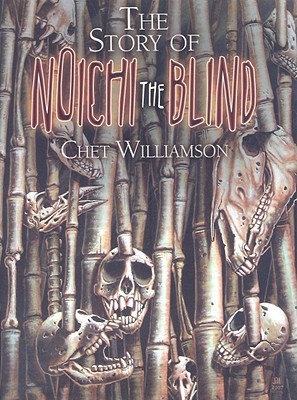 Cemetery Dance continued their winning streak with another highly eccentric publication, THE STORY OF NOICHI THE BLIND by CHET WILLIAMSON, a fascinating novella written in the style of the late Lafcadio Hearn, who specialized in ghost stories inspired by Japanese folklore. In NOICHI THE BLIND a Japan-based woodcutter takes in a young servant woman on the run from avenging samurai. The two fall madly in love, but their happiness is threatened when the woman becomes deathly ill. Noichi desperately wants to believe his lover will get better and willfully blinds himself to the fact that she’s wasting away before his eyes…and that the baby she’s pregnant with is scarcely human. This leads to much 21st Century grotesquerie in an otherwise impeccably rendered late-19th Century Japanese setting, with decidedly up-to-date depictions of necrophilia, cannibalism and dismemberment.
Cemetery Dance continued their winning streak with another highly eccentric publication, THE STORY OF NOICHI THE BLIND by CHET WILLIAMSON, a fascinating novella written in the style of the late Lafcadio Hearn, who specialized in ghost stories inspired by Japanese folklore. In NOICHI THE BLIND a Japan-based woodcutter takes in a young servant woman on the run from avenging samurai. The two fall madly in love, but their happiness is threatened when the woman becomes deathly ill. Noichi desperately wants to believe his lover will get better and willfully blinds himself to the fact that she’s wasting away before his eyes…and that the baby she’s pregnant with is scarcely human. This leads to much 21st Century grotesquerie in an otherwise impeccably rendered late-19th Century Japanese setting, with decidedly up-to-date depictions of necrophilia, cannibalism and dismemberment.
But the book is also surprisingly deep and absorbing, with the feel of an authentic folk tale and a deeply relevant message about the dangers of self-delusion. The text is bookended by an introduction explaining how this story came into Williamson’s possession, and an afterward by “Alan Drew, Ph.D.”, a (completely imaginary) scholar who fills us in on the details of Lafcadio Hearn’s fiction, and how it relates to the tale at hand. It’s one of Williamson’s most interesting works, and certainly his most unique.
NOW YOU’RE ONE OF US [ANKI] is the newest publication by Vertical, who specialize in translating worthy Japanese genre fare like Koji Suzuki’s RING novels and Hideake Sena’s PARASITE EVE. NOW YOU’RE ONE OF US, originally published in 1993 and written by the popular Japanese novelist ASA NONAMI, is a stellar addition to Vertical’s already formidable line-up.
I was unimpressed with the opening chapters, which have the newly-wed Noriko becoming suspicious of the Shitos, the wealthy family she’s married into, in the wake of a suspicious killing. It’s very ROSEMARY’S BABY-ish, with an easy-to-predict arc. As you might guess, Noriko’s new family, an unnaturally tightly-nit eight person clan, harbor some unsavory secrets.
But the book is ultimately far stranger and more sinister than such a description implies. Plied with hallucinogenic drugs and subjected to extended sleep deprivation, Noriko is drawn inexorably into the Shitos’ orbit; throughout, we’re privy to her ever-fluctuating mental state, veering inexorably from suspicion to an odd acceptance, with the latter sentiment eventually winning out as the Shitos tighten their hold. For much of its length the novel plays like a darkly-hued psychological drama, although it eventually reveals itself as an out-and-out horror story—and a particularly depraved one at that! I’m guessing the author intended this disturbing tale as a critique of contemporary Japan, with its culture of rigid conformity. It excels nonetheless as a straightforward exercise in creeping apprehension, a real triumph of so-called quiet horror.
SHORT STORIES
A fine short story collection appeared in 2007 (actually, it was published in the final weeks of ’06) called APPLE OF MY 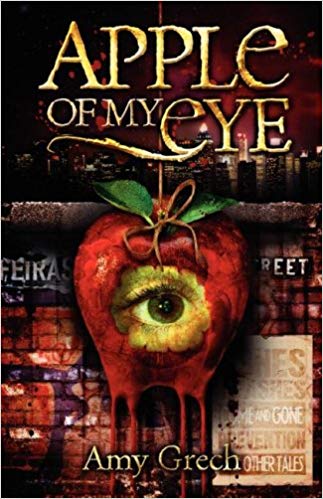 EYE by AMY GRECH (Two-Backed Books), representing a good sampling of its author’s considerable talent. If nothing else, APPLE OF MY EYE proves Grech has a mean streak, as evinced by the title story, a seriously twisted account of father-daughter love. It’s followed by “Prevention”, about a son’s nasty revenge on his neglectful mother, and “Snubbed”, an even nastier account of bloody vengeance. Yet the succeeding story is “Raven’s Revenge”, a (comparatively) subdued piece graced by a supernatural twist, and then comes “Rampart”, about a man suffering from, and eventually done in by, hallucinations—and “Damp Wind and Leaves”, an honest-to-goodness love story. But don’t get too comfortable, as “Cold Comfort”, one of the book’s meanest stories, falls in this portion. So does “Initiation Day”, which dispassionately describes how a dorky kid gets his just desserts in profoundly uncomfortable fashion. Another stand-out is the final story “EV 2000”, which with its science fictionish setting provides more evidence of Grech’s considerable range. Obviously those wanting grossness will be sated, but readers in the mood for solidly written, varied and thoughtful genre fare will also be pleased.
EYE by AMY GRECH (Two-Backed Books), representing a good sampling of its author’s considerable talent. If nothing else, APPLE OF MY EYE proves Grech has a mean streak, as evinced by the title story, a seriously twisted account of father-daughter love. It’s followed by “Prevention”, about a son’s nasty revenge on his neglectful mother, and “Snubbed”, an even nastier account of bloody vengeance. Yet the succeeding story is “Raven’s Revenge”, a (comparatively) subdued piece graced by a supernatural twist, and then comes “Rampart”, about a man suffering from, and eventually done in by, hallucinations—and “Damp Wind and Leaves”, an honest-to-goodness love story. But don’t get too comfortable, as “Cold Comfort”, one of the book’s meanest stories, falls in this portion. So does “Initiation Day”, which dispassionately describes how a dorky kid gets his just desserts in profoundly uncomfortable fashion. Another stand-out is the final story “EV 2000”, which with its science fictionish setting provides more evidence of Grech’s considerable range. Obviously those wanting grossness will be sated, but readers in the mood for solidly written, varied and thoughtful genre fare will also be pleased.
For a full dose of old timey scares, go directly to FREAKS AND FANTASIES by the late TOD ROBBINS (Ramble House). During the early 1900’s Robbins was one of the foremost horror writers on the scene, with several well received novels, poems and short stories to his credit. These days Robbins’s work has been largely forgotten but for his 1923 novella “Spurs”, which inspired Tod Browning’s notorious FREAKS (1932). The story has much in common with the flick but parts ways in its final third, wherein the spurs of the title come into play in shocking fashion, leading to a finale even more hopeless and grotesque than Browning’s. “Spurs”  is easily the most resonant tale of this collection, and very likely of Robbins’ entire oeuvre. Not that this lessens the overall effect, as the fourteen stories collected here are (mostly) solid, above-average examples of old school horror—and by old school I don’t mean the type of stately, suggestive blather that allegedly typified the genre back in olden days. This book is something of a testimonial to the fact that scary stories of old were in their own way every bit as twisted as those of today.
is easily the most resonant tale of this collection, and very likely of Robbins’ entire oeuvre. Not that this lessens the overall effect, as the fourteen stories collected here are (mostly) solid, above-average examples of old school horror—and by old school I don’t mean the type of stately, suggestive blather that allegedly typified the genre back in olden days. This book is something of a testimonial to the fact that scary stories of old were in their own way every bit as twisted as those of today.
Take the unforgettable “Who Wants a Green Bottle?” containing one of the more original conceptions of Hell I’ve encountered: a region of a deceased person’s house the soul enters by literally climbing out of its host body and passing through a tiny hole in the nearest wall. In “Wild Wullie the Waster” two warring men make peace in the afterlife, only to continue their rivalry by possessing the bodies of a pair of rosy-cheeked billiard players. And in the marrow-chilling “The Confession” we’re privy to the thoughts of a condemned murderer who recounts his meeting with a killer even more deranged and methodical than himself: a judge!
Lesser pieces include the novella-length “The Whimpus,” wherein Robbins tries for a more-or-less straightforward adventure narrative, a form that doesn’t suit him. Ditto the lighthearted whimsy of the interrelated Irish-flavored fantasies “A Bit of a Banshee” and “The Son of Shaemas O’Shea”, which came off stilted and self-indulgent. But for the most part these are terrific stories, penned by a writer of real skill. The best of them—“Who Wants A Green Bottle?”, “The Confession” and of course “Spurs”—can stand with most modern horror tales, as can the collection overall.
On the anthology circuit, the stand-out for me was WAITING FOR OCTOBER, edited by BILL BREEDLOVE (Dark Arts Books). This consistently unpredictable, genre busting book is a follow-up to Dark Arts’ well received 2006 release CANDY IN THE DUMPSTER. Like that publication, WAITING FOR OCTOBER features four authors each contributing three stories: Jeff Strand, Adam Pepper (of MEMORIA), Sarah Pinborough and DEADSTOCK’S brilliant Jeffrey Thomas (see below). The opening story, “Gramma’s Corpse” by Jeff Strand, is what you might call a grabber. It concerns a kid who as punishment for getting bad grades is forced to sleep with his grandmother’s rotting cadaver! I also got a kick out of Adam Pepper’s “Old Maid Syndrome”, an intense, stomach-churning horror tale that somehow doesn’t announce itself as such until the final third—the very last page, in fact! And how ‘bout Sarah Pinborough’s sci fi-tinged “Express Delivery”, in which the concept of cloning is given a disturbing workout? It’s a definite mind-bender.
However, it’s Jeffrey Thomas’s stories that really elevate this collection to classic status. All three tales are small masterworks, with spot-on characterizations, page-turning narratives and a real understanding of the inner workings of fear and apprehension. “The Hosts”, about worm-like creatures loose in kids’ heads, is at once repellant, sad and unnervingly true to life. “Adoration” twists the traditional zombie tale in an entirely new direction in its demented account of a lonely man who pays money to have sex with the reanimated corpse of Marilyn Monroe. And the head-scratching “Star Est Control” takes the Philip K. Dick-inspired idea of living, breathing advertisements to wildly surreal heights. For me the magic of WAITING FOR OCTOBER is in its incredibly wide-ranging, consistently unpredictable contents. Those who claim there’s nothing new in the horror story universe (i.e. me) need to read this book—as, in my view, does everyone else!
SERIES NOVELS
We mustn’t forget DAYWATCH by SERGEI LUKYANENKO (Miramax Books). It’s the second volume of Russian 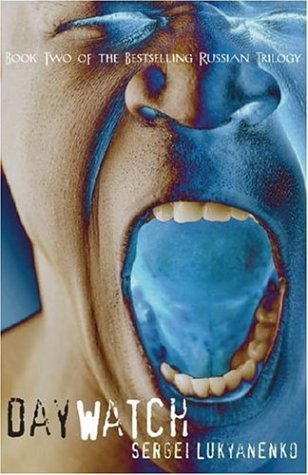 author Sergei Lukyanenko’s WATCH trilogy, and retains all the wit, imagination and rapid-fire action of NIGHTWATCH, which made its English language debut last year. Quintessentially Russian in conception and execution, these books concern the “Others”, supernaturally-endowed humans who divide themselves into light and dark factions, with the former holding a night watch and the latter a day watch to keep each other in line. The previous book was told from the vantage point of the Nightwatchers, while this one views things from the side of the Daywatchers. The Dark Others were portrayed as slimy, scheming assholes in volume one, but here they seem fairly reasonable, with the Light Others seen as self-important hypocrites.
author Sergei Lukyanenko’s WATCH trilogy, and retains all the wit, imagination and rapid-fire action of NIGHTWATCH, which made its English language debut last year. Quintessentially Russian in conception and execution, these books concern the “Others”, supernaturally-endowed humans who divide themselves into light and dark factions, with the former holding a night watch and the latter a day watch to keep each other in line. The previous book was told from the vantage point of the Nightwatchers, while this one views things from the side of the Daywatchers. The Dark Others were portrayed as slimy, scheming assholes in volume one, but here they seem fairly reasonable, with the Light Others seen as self-important hypocrites.
Like NIGHTWATCH, this book has an epic canvas divided into three more-or-less self-contained portions. Part one concerns a witch, a Dark Other, who while working at a Daywatch-sponsored summer camp falls in love with a dashing man, unaware he’s an agent of the Light Others; the consequences for this illicit affair are far-reaching and catastrophic for both. In part two a man with no memory of who he is or what he’s done inadvertently becomes involved in a series of gruesome murders. Part three introduces us to the Inquisitioners, whose task it is to keep watch over the Light and Dark Others and mete out punishments for those who disobey the rules.
It’s all incredibly complex, with an extremely involved series of regulations and a supporting cast that numbers in the dozens—although I’m told this is all reflective of life in modern-day Russia, where these books are a cultural phenomenon. FYI, the movie version of DAYWATCH was released in the US in the summer of ‘07, but don’t let that put you off reading the book. It’s quite different from the film, which contains many pleasures of its own but can’t hope to compete with the bold, kinetic charge this novel provides.
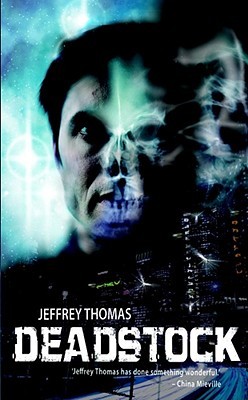 DEADSTOCK (Solaris) marked the long-time-coming mass market debut of JEFFREY THOMAS. It’s the latest entry in Thomas’ popular Punktown series, and while it isn’t the best of the saga (that in my view would be 2003’s MONSTROCITY), it is fascinating and gruesome in a manner unique to this author. Punktown is a crime-ridden city located on a distant planet inhabited by an unruly mix of Earth-born humans and various mutant races. Both factions are amply represented in this sprawling novel, which contains a dozen or so major characters, including several foot soldiers in an interstellar gang war, a couple down-and-outers, millionaires, porn impresarios and one Jeremy Stake, a private dick who happens to be a shape-shifting mutant.
DEADSTOCK (Solaris) marked the long-time-coming mass market debut of JEFFREY THOMAS. It’s the latest entry in Thomas’ popular Punktown series, and while it isn’t the best of the saga (that in my view would be 2003’s MONSTROCITY), it is fascinating and gruesome in a manner unique to this author. Punktown is a crime-ridden city located on a distant planet inhabited by an unruly mix of Earth-born humans and various mutant races. Both factions are amply represented in this sprawling novel, which contains a dozen or so major characters, including several foot soldiers in an interstellar gang war, a couple down-and-outers, millionaires, porn impresarios and one Jeremy Stake, a private dick who happens to be a shape-shifting mutant.
Stake is contracted by a wealthy CEO to track down a one-of-a-kind robot doll that’s been stolen from the CEO’s teenage daughter. The doll turns out to be a malevolent entity that furthers itself by consuming everything in sight, growing into a literal monster and attracting a horde of mutant followers, eventually coming to threaten the entirety of Punktown—and by extension the rest of the world. Nobody else combines sci fi and horror quite like Jeffrey Thomas; here he’s crafted a memorable melding of Philip K. Dick-ian speculation and Lovecraftian grotesquerie. There may perhaps be a few too many extraneous characters and subplots (and the 400-plus page count may be a mite excessive), but it’s refreshing to find a novel this dense and multi-faceted, presenting a richly imagined world with uncommon skill and panache.
BOOKS ABOUT MOVIES
In the nonfiction sphere, I strongly urge you film buffs out there to check out PHALLIC FRENZY: KEN RUSSELL AND HIS FILMS by JOSEPH LANZA (Chicago Review Press). This isn’t the first book about the English cinema’s premiere enfant terrible Ken Russell, whose films include crazed masterworks like THE DEVILS, ALTERED STATES and THE LAIR OF THE WHITE WORM, but it is very likely the best. That’s largely due to the simple fact that the others—which include John Baxter’s AN APPALLING TALENT (1973), Colin Wilson’s KEN RUSSELL: A DIRECTOR IN SEARCH OF A HERO (1974) and Russell’s own A BRITISH PICTURE (a.k.a. ALTERED STATES; 1991)—were all published some time ago, while this one is at least up-to-date.
Author Joseph Lanza provides a terrific overview of his subject’s life and career, relating how Ken Russell grew up in the seaside town of Southampton, England, where he was traumatized for life by a film called THE SECRET OF THE LOCH, along with warring parents and a teenage stint in the Royal Navy. Russell later made several scandalous, rule-breaking films for the BBC, like DELIUS: SONG OF SUMMER and DANTE’S INFERNO. His first feature of note was BILLION DOLLAR BRAIN, a Michael Caine-headlined inversion on traditional James Bond themes, followed by the tasteful WOMEN IN LOVE, Russell’s apparent “masterpiece”, and THE MUSIC LOVERS, arguably a true masterpiece.
Lanza is careful to mention all his subject’s subsequent films, operas, TV projects and novels, and also fills us in on many Ken Russell projects that never came to fruition, such as a Sarah Bernhardt biopic that was to star Barbara Streisand and a Bob Guccione produced adaptation of MOLL FLANDERS. Lanza can’t help but close the book out on a depressing note, with the now-eightyish Russell finding himself persona non grata in Hollywood and reduced to looking for a mate on the internet. A woman did respond to his online proposal and the marriage commenced; it’s apparently still going strong, even if Russell’s movie career isn’t.
There’s also ANARCHY AND ALCHEMY: THE FILMS OF ALEJANDRO JODOROWSKY by BEN COBB (Creation  Books). This is a long overdue volume, and if you ask me an essential one, a thorough study of the films of Alejandro Jodorowsky, arguably the premiere wild man of the cinema. Jodorowsky is of course the creator of the midnight movie classic EL TOPO, as well as the mind-roasting HOLY MOUNTAIN, the scandalous FANDO Y LIS (which caused riots upon its premiere in Mexico) and the surreal carny-themed horror fest SANTA SANGRE. Author Ben Cobb covers the production, reception and narrative of each film in depth. Alas, he also devotes an equal amount of time to lesser Jodorowsky projects like his unimpressive debut short LA CRAVATE, his misguided children’s film TUSK, and his thoroughly uninspired Hollyweird production THE RAINBOW THIEF, which is unfortunately Jodorowsky’s most recent film.
Books). This is a long overdue volume, and if you ask me an essential one, a thorough study of the films of Alejandro Jodorowsky, arguably the premiere wild man of the cinema. Jodorowsky is of course the creator of the midnight movie classic EL TOPO, as well as the mind-roasting HOLY MOUNTAIN, the scandalous FANDO Y LIS (which caused riots upon its premiere in Mexico) and the surreal carny-themed horror fest SANTA SANGRE. Author Ben Cobb covers the production, reception and narrative of each film in depth. Alas, he also devotes an equal amount of time to lesser Jodorowsky projects like his unimpressive debut short LA CRAVATE, his misguided children’s film TUSK, and his thoroughly uninspired Hollyweird production THE RAINBOW THIEF, which is unfortunately Jodorowsky’s most recent film.
EL TOPO, THE HOLY MOUNTAIN and SANTA SANGRE are filled with an encyclopedia-worth of arcane symbolism and literary references, and any serious study of them must take those symbols and portents into account. Ben Cobb is up to the task, providing voluminous footnotes referencing the many, many mystical and alchemical elements Jodorowsky packs into his films. You may find the author’s exhaustiveness in this regard dull or even off-putting, but it’s necessary in dealing with films like these.
Cobb is also careful to let Jodorowsky’s insanely colorful personality shine through, with innumerable quotes from a plethora of sources and a lengthy concluding interview. Jodorowsky’s charmingly clipped English (“What you need to do…you need to do it because maybe tomorrow you die”), decidedly idiosyncratic worldview and wild recollections (such as a childhood “memory” of floating into the air and encountering a ghost plane filled with vampires) add up to a mighty unique man, one of the VERY small handful of filmmakers who’s every bit as interesting as the films he makes.
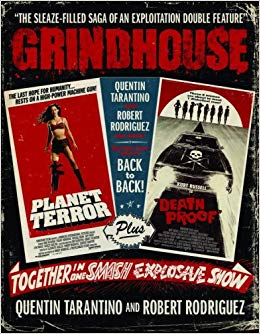 Another recommended movie-related tome is GRINDHOUSE: THE SLEAZE-FILLED SAGA OF AN EXPLOITAITON DOUBLE FEATURE by QUENTIN TARANTINO and ROBERT RODRIGUEZ (and edited by KURT VOLK; Weinstein Books). I know I’m certain to get shit for recommending a movie promo book, especially since the flick in question was a huge flop. I’ll have to say, though, that the two-part GRINDHOUSE, consisting of exploitation mini-features by Robert Rodriguez and Quentin Tarantino, was one of my absolute favorite films of ’07, and I find this large format hardcover a terrific companion piece. It’s lovingly designed and executed, with a wealth of colorful stills, production sketches, promo art and storyboards.
Another recommended movie-related tome is GRINDHOUSE: THE SLEAZE-FILLED SAGA OF AN EXPLOITAITON DOUBLE FEATURE by QUENTIN TARANTINO and ROBERT RODRIGUEZ (and edited by KURT VOLK; Weinstein Books). I know I’m certain to get shit for recommending a movie promo book, especially since the flick in question was a huge flop. I’ll have to say, though, that the two-part GRINDHOUSE, consisting of exploitation mini-features by Robert Rodriguez and Quentin Tarantino, was one of my absolute favorite films of ’07, and I find this large format hardcover a terrific companion piece. It’s lovingly designed and executed, with a wealth of colorful stills, production sketches, promo art and storyboards.
It is in most respects a traditional making-of piece, complete with junket-worthy blurbs from the cast and crew of GRINDHOUSE about how dedicated everyone was and how great everything turned out. But the book excels in the way it communicates just how much skill and hard work went into this production, which if you ask me is fully evident in the finished product. Highlights include a gallery of the flamboyant wardrobes sported by the cast of Rodriguez’s segment, as well as a chapter of fun recollections by the stuntmen on Tarantino’s portion, and brief looks at the making of two of GRINDHOUSE’S fake trailers.
I’d have liked more info on the grindhouse moviegoing experience to which Tarantino and Rodriguez were paying homage, because as it is that’s only covered in a brief conversation between the two that opens the book. This of course brings up a prime reason GRINDHOUSE lost money: a large portion of its intended audience had no idea of the title’s meaning or significance, and the publicity failed to educate them. Thus this book is significant on two counts, illuminating how the movie succeeded artistically and failed financially.
A BOOK WITH WORDS AND PICTURES
Now it’s time for the graphic novel part of the list, and a particularly strong entry you more than likely passed over: THE 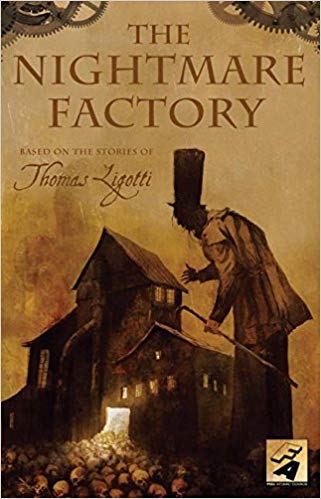 NIGTHMARE FACTORY, a graphic anthology from the incomparable THOMAS LIGOTTI (Fox Atomic). It contains four Ligotti tales, each illustrated by a different and distinct artist. This ensures a wide range of styles, from the old-fashioned paneled illustrations of SPIDERMAN’S Colleen Doran to the dark, dimly glimpsed evocations of 30 DAYS OF NIGHT’S Ben Templesmith. Such a multi-faceted approach works well with Ligotti’s elegant, dreamy tales, which, undeniably brilliant though they are, tend to suffer from a slight case of sameness. Masks are a favorite theme of Ligotti’s, as are dolls and/or mannequins, and the idea of an individual or entire community sucked into a Lovecratian nightmare. All those things turn up in this collection.
NIGTHMARE FACTORY, a graphic anthology from the incomparable THOMAS LIGOTTI (Fox Atomic). It contains four Ligotti tales, each illustrated by a different and distinct artist. This ensures a wide range of styles, from the old-fashioned paneled illustrations of SPIDERMAN’S Colleen Doran to the dark, dimly glimpsed evocations of 30 DAYS OF NIGHT’S Ben Templesmith. Such a multi-faceted approach works well with Ligotti’s elegant, dreamy tales, which, undeniably brilliant though they are, tend to suffer from a slight case of sameness. Masks are a favorite theme of Ligotti’s, as are dolls and/or mannequins, and the idea of an individual or entire community sucked into a Lovecratian nightmare. All those things turn up in this collection.
The opening tale, “The Last Feast of Harlequin”, is a vaguely Lovecraftian story about a festival held by masked revelers in an accursed town—and the dark secrets that underlie it all. “Dream of a Mannikin” follows, being a short account of a man whose sense of reality is unraveled by his scheming girlfriend. “Dr. Locrain’s Asylum” concerns a malady of madness that spreads forth from an upper room of the titular residence. Finally there’s “Teatro Grottesco”, a downright puzzling piece about a trouble-making acting troupe that assaults creative types (an oblique commentary on the age-old battle of art vs. commerce).
The stories form a good sampling of Ligotti’s output; “The Last Feast of Harlequin” is about as commercial as this author gets, while “Teatro Grottesco” represents Ligotti at his quirkiest. All the artists do stand-out work, particularly Ted McKeever in his impressionistic rendering of “Dr. Locrian’s Asylum”, and Michael Gaydos, who provided the gorgeous watercolors of “Teatro Grottesco”. Credit must also go to Stuart Moore and Joe Harris, who scripted the comic versions of Ligotti’s stories and did so in a manner that allows the words and visuals to (mostly) harmonize.
OLD BOOKS GIVEN NEW LIFE
We mustn’t forget the reprints, of which there were three worthy examples in 2007 (far less than the dozen or so we got last year, but still better than none!). First and foremost was Chicago Review Press’s reissue of SHANE STEVENS’ classic thriller BY REASON OF INSANITY. This epic masterwork remains a blistering, unputdownable achievement, a large-scale serial killer saga that predated the books of Thomas Harris and his progeny by several years. Be forewarned, though, that the book’s a rough one, with several vivid episodes of sexual violence that have remained fresh in my mind since my first reading over a decade ago. But those unafraid of an unblinking glimpse into the darkest depths of madness are urged to read this book. It is quite simply the best of its kind!
Speaking of rough novels, WRATH JAMES WHITE and EDWARD LEE’S 2003 gross-out favorite TERATOLOGIST was given a new printing by Overlook Connection. It has a young multi-millionaire and all-around lunatic looking to lure God onto our plane and capture him. This nut packs a secluded mansion with an assortment of human oddities and influential leaders, and injects them all with an illegal drug that jacks up peoples’ sex drives. In this way he hopes to get God so pissed off that He’ll have to show up on Earth and personally put a stop to the madness.
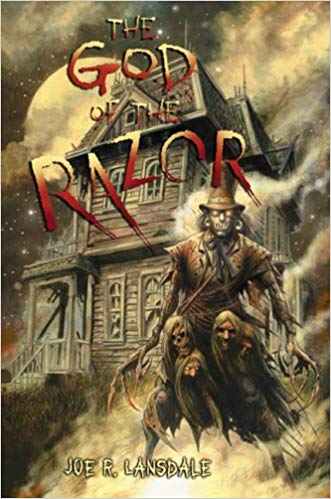 Sound like fun? If so than this is the book for you, and it’s now available in a newly revised, semi-affordable edition (with the original Medium Rare publication now a rare collector’s item).
Sound like fun? If so than this is the book for you, and it’s now available in a newly revised, semi-affordable edition (with the original Medium Rare publication now a rare collector’s item).
THE GOD OF THE RAZOR (Subterranean Press) was a twentieth anniversary hardcover edition of JOE LANSDALE’S blistering novel THE NIGHTRUNNERS, together with six related short stories. The novel’s a toughie, relating, in profoundly harsh, graphic fashion, what happens when a young woman is viciously gang-raped by a pack of psychotic teenagers, leading to an arrest, a suicide and a final showdown of wrenching intensity. The book, a straightforward suspensor, has a perplexingly choppy flow (the likely consequence of its having been constructed around three short stories), but does its job nonetheless. Although first published in 1987, it was actually written seven years earlier (as Lansdale claims in a newly written intro), making it one of its author’s very first novels; he may not have quite found his footing yet, but Lansdale, even at such an early stage of his career, really knew how to kick ass!
The short stories included center mostly on the God of The Razor, who has what amounts to an extended cameo in THE NIGHTRUNNERS. This personage is helpfully fleshed out in tales like “God of the Razor” and the newly written “Janet Finds the Razor”. There’s also “Not from Detroit”, once intended as part of THE NIGHTRUNNERS, and “Incident On and Off a Mountain Road”, which admittedly has nothing to do with the GOTR or the novel in question, but, in its author’s words, “What the hell. It’s a fun story.” I fully agree.
A LITTLE OFF TOPIC, BUT…
I’ll venture a bit outside the horror genre for my final selection (it’s my list and I’ll write about what I like, thank you very 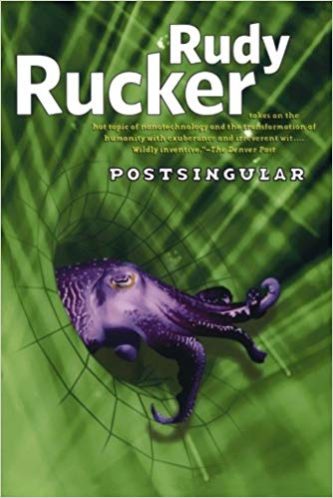 much!), POSTSINGULAR by RUDY RUCKER (Tor). It’s a typically wild and crazy cyberpunk extravaganza by one of the sci fi genre’s most distinctive talents, which I feel compelled to mention because a). it’s a terrific novel, and b). the author made it available as a free online download, with the stipulation that we help him out by spreading the word.
much!), POSTSINGULAR by RUDY RUCKER (Tor). It’s a typically wild and crazy cyberpunk extravaganza by one of the sci fi genre’s most distinctive talents, which I feel compelled to mention because a). it’s a terrific novel, and b). the author made it available as a free online download, with the stipulation that we help him out by spreading the word.
It would be unfair to give too much away, as the book’s pleasure is in its consistently unpredictable, lightning-paced contents, which include a brand of self-replicating “nanobots” that take over the universe, and an apparently improved nanobot model that’s actually even more destructive than the old one. Only Rudy Rucker, who possess one of the planet’s most unique minds, could possibly have concocted a story like this one. It’s totally bonkers yet staunchly logical, with a streak of anarchic comedy that’s among Rucker’s trademarks. If you’ve read any of Rudy Rucker’s early novels (WHITE LIGHT, SOFTWARE, THE SEX SPHERE) you’ll find POSTSINGULAR a welcome return to form, whereas if you’re unfamiliar with his work it’ll be a great place to start.
ADIOS 2007!
On that note I’ll bid the year 2007 a fond goodbye. Again, it was a good year for genre literature, and I can only hope the books of 2008 are as strong. Luckily the indicators are promising, with upcoming titles by the likes of Stephen King, Ramsey Campbell, J.G. Ballard, Jack Ketchum, Ray Garton and many others. In short, it doesn’t look as if there will be any shortage of good reading in ‘08, and I promise to cover as much of it as I possibly can.
